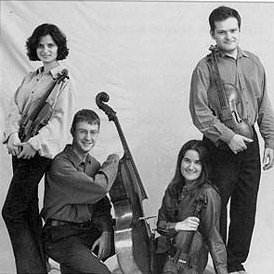I was eager to hear the Belceas tackle large scale late Beethoven, having vivid memories of them tearing into Op 95 at the London International String Quartet Competition (due to be held again this Spring). They took our breath away and landed a worthy third prize against strong competition - another British quartet, the Vellingers, won and both have steadily cemented their reputations. Chamber music is no longer a poor relation in London concerts. The Wigmore Hall was packed by its knowledgeable audience - so is Conway Hall regularly for string quartets on Sunday evenings.Ideally contrasted, this programme began with an impressive, subtly nuanced performance of the Mozart and a smooth, deeply expressive one of Britten's haunting No 3, his last important composition, closely linked to the opera Death in Venice and completed when his own life was nearing its end.
It was, though, Op 130, played with the Grosse Fuge, that brought in the Saturday night crowds and that will stay in the memory, being a performance which overturned received notions about this problematic work, thought too much for contemporary audiences and published with a lighter alternative finale.
How times have moved on! The first movement, constantly changing in speed and style, had a lighter touch than usual, allowing one to savour its constant inventiveness, something happening in every phrase and bar. Often it feels, rather, a comparatively weighty overture to balance the huge structure and prepare for the massive finale in the distant future, a complex multiple fugue which is often so stressful as to trap seasoned players, sometimes verging on the incoherent (usually, not so many decades ago!) and making the listener marvel at Beethoven's uncompromising modernism.
I have always thought of the middle four movements as serenade-like, only the Cavatina, often played very slowly and with deepest intensity, bridging the way to the rigours of the Great Fugue. But the Belceas had established a divertimento, serenade-like style from the outset of this six-movement quartet, not needing the presto to provide lighter relief. Their presto was very fast indeed, emphasising the bizarre, innovative effect of Beethoven's hairpins; it passed like the wind. The andante con moto, non troppo took us easily onwards, and the German dance brought to mind those 18th century Suites with substantial overtures followed by a series of dances. The Cavatina, initially to my disappointment, moved on and was expressive without allowing any ponderous wallowing in implicit tragedy. How would the transition to the Grosse Fuge fit in? The answer was that it too was taken easily and lightly, with great clarity in the part writing and each section nicely characterised; still part of the same quartet. They arrived at the end easily, and for once the brusque suddenness of the ending, with no rallentando, seemed entirely appropriate.
The Belceas only missed one trick, which they should consider next time. They seemed not at all exhausted, nor were we. A Mozart minuet & trio was an unsuitable encore. In this interpretation of Op 130 they had paved the way, unwittingly perhaps, to give us the published allegro finale, which would have been just right and sent us on our way exhilarated, leaving us with even more to ponder about how a masterpiece changes with the developing skills of musicians, the aural experiences of later generations of listeners, and the passage of the centuries. A first reviewer found the first, third and fifth movements serious, gloomy, rough and wilful, and the fugal finale as incomprehensible as Chinese - later commentators have generally assumed that the sense of struggle against the medium was essential to the conception. What sort of quartet did Beethoven think it was that he had composed in 1822?
Peter Grahame Woolf

 Return to:
Return to: